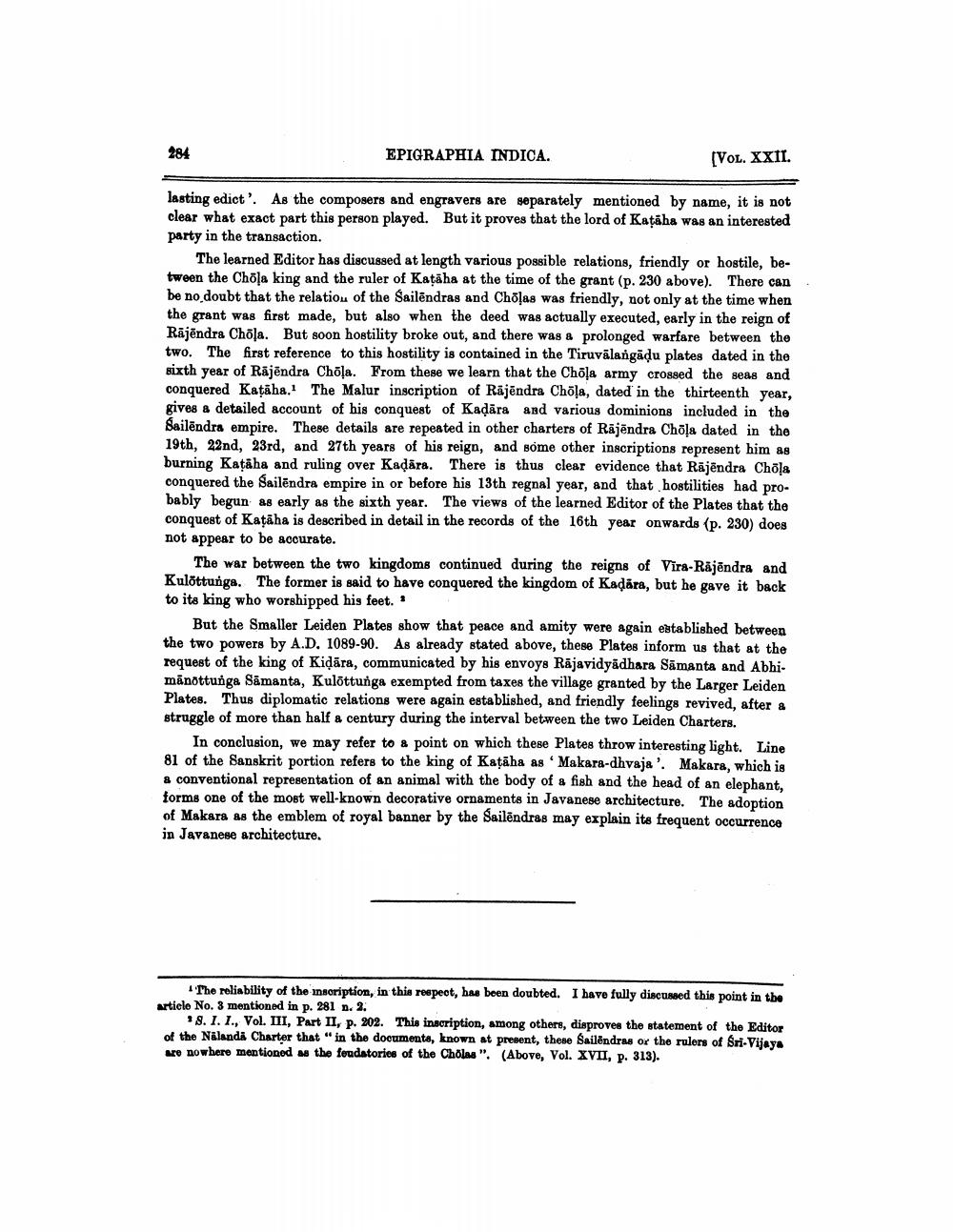________________
284
EPIGRAPHIA INDICA.
[VOL. XXII.
lasting edict'. As the composers and engravers are separately mentioned by name, it is not clear what exact part this person played. But it proves that the lord of Katäha was an interested party in the transaction.
The learned Editor has discussed at length various possible relations, friendly or hostile, between the Chola king and the ruler of Kaţāha at the time of the grant (p. 230 above). There can be no doubt that the relatiou of the Sailendras and Choļas was friendly, not only at the time when the grant was first made, but also when the deed was actually executed, early in the reign of Rajendra Chola. But soon hostility broke out, and there was a prolonged warfare between the two. The first reference to this hostility is contained in the Tiruvālangãdu plates dated in the sixth year of Rājēndra Chõļa. From these we learn that the Chõļa army crossed the seas and conquered Kataha. The Malur inscription of Rājēndra Chola, dated in the thirteenth year, gives a detailed account of his conquest of Kadāra and various dominions included in the Sailēndra empire. These details are repeated in other charters of Rajendra Chola dated in the 19th, 22nd, 23rd, and 27th years of his reign, and some other inscriptions represent him as burning Katäha and ruling over Kadāra. There is thus clear evidence that Rājēndra Chola conquered the Sailēndra empire in or before his 13th regnal year, and that hostilities had probably begun as early as the sixth year. The views of the learned Editor of the Plates that the conquest of Kaţāha is described in detail in the records of the 16th year onwards (p. 230) does not appear to be accurate.
The war between the two kingdoms continued during the reigns of Vira-Rajēndra and Kulõttunga. The former is said to have conquered the kingdom of Kadira, but he gave it back to its king who worshipped his feet."
But the smaller Leiden Plates show that peace and amity were again established between the two powers by A.D. 1089-90. As already stated above, these Plates inform us that at the request of the king of Kidāra, communicated by his envoys Rājavidyadhara Samanta and Abhimanottunga Sämanta, Kulottunga exempted from taxes the village granted by the Larger Leiden Plates. Thus diplomatic relations were again established, and friendly feelings revived, after a struggle of more than half a century during the interval between the two Leiden Charters.
In conclusion, we may refer to a point on which these Plates throw interesting light. Line 81 of the Sanskrit portion refers to the king of Kaţāha as Makara-dhvaja'. Makara, which is a conventional representation of an animal with the body of a fish and the head of an elephant. forms one of the most well-known decorative ornaments in Javanese architecture. The adoption of Makara as the emblem of royal banner by the Sailendras may explain its frequent occurrence in Javanese architecture.
The reliability of the inscription, in this respect, has been doubted. I have fully discussed this point in the article No. 3 mentioned in p. 281 n. 2.
18. 1. I., Vol. III, Part II, p. 202. This inscription, among others, disproves the statement of the Editor of the Nalanda Charter that " in the documenta, known at present, these Sailendras or the rulers of Sri-Vijaya are nowhere mentioned as the foudatories of the Cholas". (Above, Vol. XVII, p. 313).




